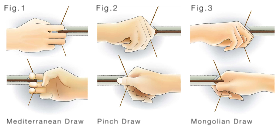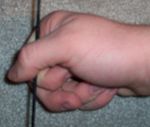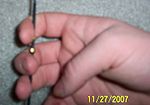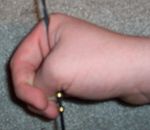
Bow draw
Encyclopedia

Bow (weapon)
The bow and arrow is a projectile weapon system that predates recorded history and is common to most cultures.-Description:A bow is a flexible arc that shoots aerodynamic projectiles by means of elastic energy. Essentially, the bow is a form of spring powered by a string or cord...
. Currently, the most common method is the Mediterranean draw, long the usual method in European archery
Archery
Archery is the art, practice, or skill of propelling arrows with the use of a bow, from Latin arcus. Archery has historically been used for hunting and combat; in modern times, however, its main use is that of a recreational activity...
. Other methods include the pinch draw and the Mongolian draw.
Pinch draw or "primary release"

Arrow
An arrow is a shafted projectile that is shot with a bow. It predates recorded history and is common to most cultures.An arrow usually consists of a shaft with an arrowhead attached to the front end, with fletchings and a nock at the other.- History:...
between the thumb and index finger. Most people use this draw naturally when they first start shooting. The advantage of this draw is that the release is very clean; when the pull reaches a certain point, friction can no longer hold the arrow and it flies free. However, this release prevents the drawing of a stiff bow unless the archer possesses enormous strength in the fingers. It was widespread in traditional archery in the Americas and is seen (with the Mediterranean draw) in the earlier Assyrian reliefs of Ashurnasirpal II. The arrow may be placed on either side of the bow.
Variations
In the "secondary release" the forefinger and thumb pinch the arrow end as in the primary release. Additionally, the middle and ring fingers are used to hold the string. This is further developed in the "tertiary release"; the forefinger not only presses on the arrow end, but also grasps the string. These variants were also used in the Americas, appear on the reliefs of SennacheribSennacherib
Sennacherib |Sîn]] has replaced brothers for me"; Aramaic: ) was the son of Sargon II, whom he succeeded on the throne of Assyria .-Rise to power:...
and have been described from Thailand and the Andaman Islands. It may be used by Scythian archers depicted on Greek black-figure pottery
Black-figure pottery
Black-figure pottery painting, also known as the black-figure style or black-figure ceramic is one of the most modern styles for adorning antique Greek vases. It was especially common between the 7th and 5th centuries BC, although there are specimens dating as late as the 2nd century BC...
.
Mediterranean draw, Mediterranean release

The Mediterranean draw or its variants is the only traditional form attested in Europe; it is also native to the Middle East, appearing on Assyria
Assyria
Assyria was a Semitic Akkadian kingdom, extant as a nation state from the mid–23rd century BC to 608 BC centred on the Upper Tigris river, in northern Mesopotamia , that came to rule regional empires a number of times through history. It was named for its original capital, the ancient city of Assur...
n carvings at all periods. The Hadza, who do not use quivers, may hold other arrows with the free thumb and little finger. At present this is by far the most popular method of drawing a bow. It is now used by almost all recurve, traditional, and bare-bow shooters.
Variations
There are variations of this that include the use of only two fingers. This may allow for a cleaner release. However, more pressure is put on the two fingers, resulting in more strain. Currently, this draw method is little used. It has been described in use by Eskimo archers, and appears on SassanianSassanid Empire
The Sassanid Empire , known to its inhabitants as Ērānshahr and Ērān in Middle Persian and resulting in the New Persian terms Iranshahr and Iran , was the last pre-Islamic Persian Empire, ruled by the Sasanian Dynasty from 224 to 651...
royal pictures.
Barebow and longbow archers often have the index, middle and ring fingers on the string all below the arrow. This brings the arrow closer to the eye, facilitating "point of aim" and instinctive shooting, and allows the archer to use the "string walking" aiming technique.
Mongolian draw, Mongolian release

Ishi
Ishi was the last member of the Yahi, the last surviving group of the Yana people of the U.S. state of California. Ishi is believed to have been the last Native American in Northern California to have lived most of his life completely outside the European American culture...
, the last of the Yana
Yana
Yana may refer to:Places* Yana, an administrative capital in Bauchi State, Nigeria* Yana, Burma, a village in Hkamti Township in Hkamti District in the Sagaing Region of northwestern Burma...
, with his short bows.
It gives a narrower grip on the string, as only one digit is used, and this may help to avoid "string pinch" with shorter bows such as the composite bow
Composite bow
A composite bow is a bow made from horn, wood, and sinew laminated together. The horn is on the belly, facing the archer, and sinew on the back of a wooden core. Sinew and horn will store more energy than wood for the same length of bow...
s normally used from horseback. It may also avoid a problem occasionally faced by archers using the Mediterranean release, when the three fingers do not release at exactly the same time and thus foul the draw. It also positions the string further back in the hand, allowing a longer draw, all else being equal. This release is normally used with the arrow on the right side of the bow for a right-handed archer, and on the left side of the bow for a left-handed archer.
Equipment
Protective equipment is normally used to protect the skin of the digits used. For the Mediterranean draw, the fingers may be protected with shooting gloves or by finger tabFinger tab
A finger tab or Archer Tab used in archery is a small leather or synthetic patch that protects an archer's fingers from the bowstring. It is strapped or otherwise attached to an archer's hand. In summertime, tabs are far more comfortable than gloves and can more conveniently use thicker material...
s. A shooting glove is a three-fingered glove that goes on the primary hand of the shooter. Models range from full-finger leather to gloves that only cover the tips of the fingers. These gloves are used mostly by traditional and bare-bow shooters. Finger tabs are pieces of material that are attached via leather straps or holes to the middle finger. For amateurs a plain tab made of leather is a simple, cheap, and still highly effective protection for the fingers.
Thumb ring
Thumb ring
A thumb ring is a piece of equipment designed to protect the thumb during archery. This is a ring of leather, stone, horn, wood, ivory, metal, ceramics, plastic, or glass or which fits over the end of the thumb, coming to rest at the outer edge of the outer joint...
s or leather thumb tabs are used by archers practising the Mongolian release. Most cover and protect the skin of the thumb only. The Japanese yugake is a reinforced glove with a special ridge which holds the string.
In the past 25 years, with the advent of the compound bow
Compound bow
A compound bow is a modern bow that uses a levering system, usually of cables and pulleys, to bend the limbs.The limbs of a compound bow are much stiffer than those of a recurve bow or longbow. This limb stiffness makes the compound bow more energy-efficient than other bows, in conjunction with the...
, mechanical releases have become popular. The mechanism is usually attached to the wrist; it holds the string, and releases it when triggered. They offer a cleaner release and require no finger strength. However, finger releases must be used for bows other than compounds in most tournaments (including the International Archery Federation
International Archery Federation
The International Archery Federation is the governing body of the sport of archery. It is based in Lausanne, Switzerland. It is composed of 140 national archery associations, and is recognized by the International Olympic Committee.-History:FITA was founded on 4 September 1931 in Poland...
) and thus are still widely used.

